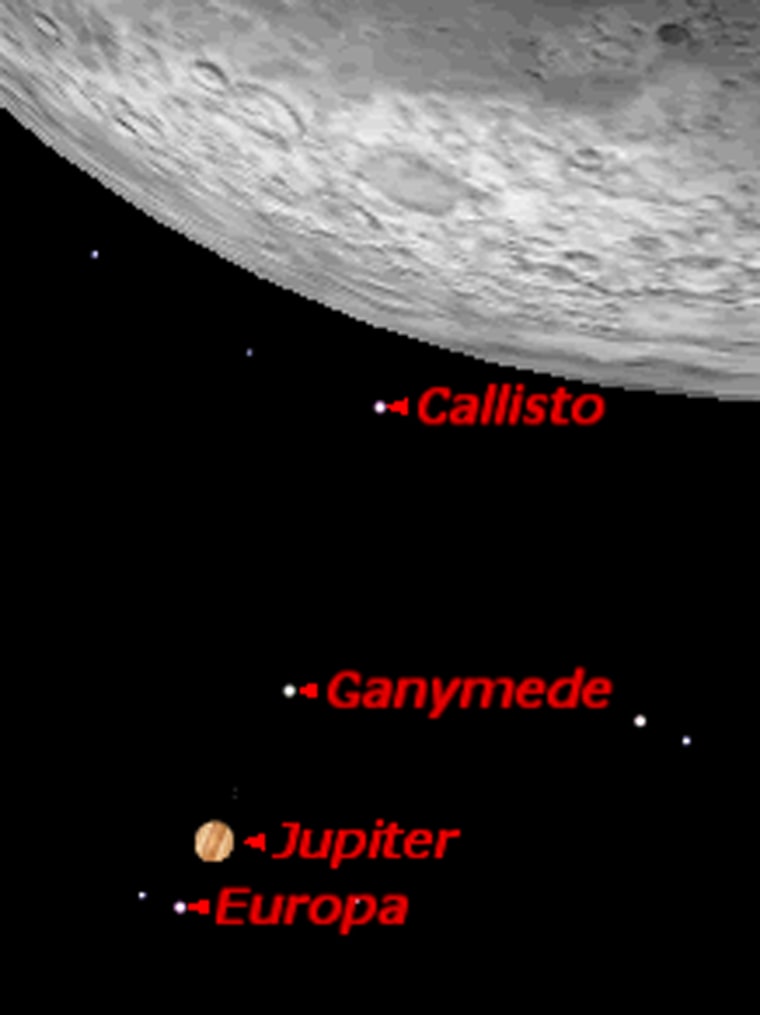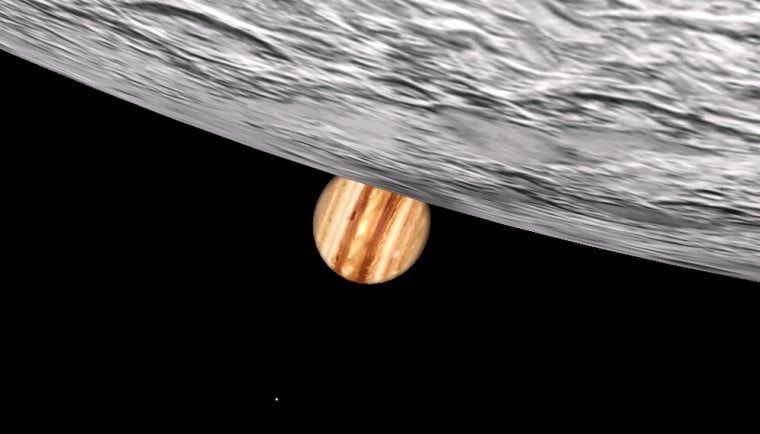A rare and spectacular event will occur early Tuesday when the brilliant planet Jupiter and three of its largest satellites pass behind Earth's moon.
Astronomers refer to this phenomenon as an "occultation," taken from the Latin occultare, which means “to conceal.” This eye-catching sight will be visible in complete darkness across all of eastern and much of central North America.
The waning moon will be 26 percent illuminated, a crescent just 4½ days before the moon's new phase.
It's been decades since Jupiter has played hide-and-seek for U.S. skywatchers under favorable dark-sky circumstances. Across the western and central states, Jupiter was occulted at dawn on Oct. 19, 1968, in a widely watched event. For viewers farther east, the wait has been considerably longer.
The last time New Yorkers were treated to such a favorably placed dark-sky Jupiter occultation was on Sept. 3, 1889. After 2004, there will not be another similarly favorable Jupiter occultation for most North Americans until Oct. 6, 2026.
Where it's visible
Earth's moon and Jupiter are of course very far apart, but they both travel in roughly the same plane of space, making an occultation possible when the geometry is just right. What you will see (or not see) depends on location.
Along the Eastern Seaboard, the moon will be more than 20 degrees above the horizon when it covers Jupiter in the predawn hours. (Your clenched fist, held at arm’s length, measures approximately 10 degrees in width.) The moon will have risen to more than 30 degrees above the east-southeast horizon by the time Jupiter begins to reappear.
The moon’s height in the night sky will gradually diminish for viewing locations farther West.
Across the western Great Lakes, the eastern Great Plains and down into the Deep South, for example, the emergence of Jupiter occurs with the moon about 20 degrees high. Along a line from about central North Dakota down into western Texas, Jupiter’s disappearance will roughly coincide with moonrise, but when Jupiter is ready to emerge, the moon will have climbed up to an altitude of about 10 degrees.
West of this line, viewers will only be able to see Jupiter’s reappearance, with the moon quite low. Along a line running from just west of Edmonton, Alberta, south through northern Idaho, down to Nogales, Arizona, Jupiter’s emergence occurs at moonrise. To the west of this line, no occultation will occur.
Out of the 48 contiguous United States, only Washington, Oregon and California are completely shut out of this sky show, as the main event will have already taken place before the moon and Jupiter rise. But even from these localities, the sight of Jupiter hovering just above and to the right of the lunar crescent as they rise into full view will still make for a very striking sight.
Texas grazing
A most interesting sight will be seen from a centered from roughly Marfa to Matagorda in Texas, then continuing east across the Gulf of Mexico to Key West, Fla. Within this zone, the moon’s mountainous edge will be silhouetted against Jupiter for several minutes, but the planet will never be completely covered.
The graze will take place near the crescent’s southern cusp.
The best views will be seen at the northern edge of the graze zone, where the partial occultation will last the longest — about 20 minutes. San Antonio is very close to the northern edge; in the Florida Keys, the town of Marathon is also situated very near to the graze zone’s northern limit.
To the south of the graze zone, the moon will miss Jupiter, skimming just barely above it.
When to watch
The amount of time that Jupiter will be completely hidden behind the moon depends on your location, and can range from as little as a few minutes to just over an hour. This table shows when Jupiter will disappear and reappear from select cities on Dec. 7, rounded off to the nearest minute. The times are based on predictions by the International Occultation Timers Association. "Height" refers to Jupiter's height above the horizon when it disappears and reappears, measured in degrees. More detailed information, including maps of the occultation zone and times for more than 275 cities in North America, is available at the IOTA website.
What to look for
Jupiter is bright, shining at magnitude -1.8. That's brighter than any star in the sky on an astronomers' scale in which negative numbers denote the brightest objects.
You might be able to see Jupiter disappear using no optical aid at all, but binoculars or a small telescope will certainly give a much better view. The reappearance of the planet should be plainly visible to the unaided eye.
With the naked eye, Jupiter appears as a starlike point of light. But with telescopes and even binoculars it becomes a discernable disk. Observed with magnification, it will not disappear or reappear in an instant as a star would, but rather it will take an interval of time to fully occult and emerge.
For most locations, it will take the moon at least a minute to completely cover or uncover Jupiter. In south-central Texas and south Florida, just to the north of the partial occultation zone, this process could take up to three minutes or more.
The most spectacular part of this sky show will be the gradual reappearance of Jupiter from behind the moon’s dark limb.
The description of Jupiter’s gradual reappearance from behind the Moon’s dark limb in 1968 was described as "quite dramatic" as seen from Chicago. Meanwhile an observer at La Pryor, Texas, noted that the most spectacular feature for him was the naked-eye impression of Jupiter looking "like a brightening jewel on the dark limb of the Moon."
Also likely to be visible on this morning will be earthshine, a faint grayish-blue illumination of the dark part of the Moon’s disk.
This dim light is produced by sunlight striking the "dark" side of the moon after first being reflected from Earth’s surface, clouds and atmosphere. The effect will give the Moon an almost 3-D quality and will enhance the overall spectacle.
Bonus: The Galilean moons
During the occultation, it also will be possible to watch three of Jupiter's four largest satellites disappear.

The moons will likely be lost in the glare of the bright lunar crescent just before they disappear behind the moon, but their emergence from behind the moon’s dark side should be readily visible through binoculars or a small telescope.
Callisto will emerge from behind the moon’s dark limb about 13 or 14 minutes before Jupiter itself, followed by Ganymede about 9 or 10 minutes later. Then, just about one or two minutes after Jupiter has fully reappeared, Europa will come into view.
Due to the angular sizes of the three Jovian moons, they will take up to a few seconds to brighten as they move out from behind the moon. The fourth Galilean satellite, Io, will be behind Jupiter and not part of the show.
Joe Rao serves as an instructor and guest lecturer at New York's Hayden Planetarium. He writes about astronomy for The New York Times and other publications, and he is also an on-camera meteorologist for , New York.
